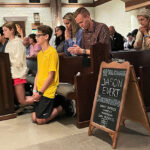When I was working and living at The Arch, the L’Arche community in Clinton, someone in the house dropped a beloved coffee mug, breaking the handle. This unfortunate event saddened me but my co-assistant Eric informed me that in Japan this mug could now be “wabi-sabi,” meaning that this new flaw adds to the mug’s beauty. Besides, he added, “There will always be a story behind that damaged cup.”
Wikipedia has this to offer on this complex idea: “In traditional Japanese aesthetics, wabi-sabi is a world view centered on the acceptance of transience and imperfection. The aesthetic is sometimes described as one of appreciating beauty that is ‘imperfect, impermanent, and incomplete’ in nature. It is prevalent in many forms of Japanese art.”
After that day, I looked at things with a different eye. My family heirloom child’s rocking chair belonged to my mother and her 10 older siblings and has a significant bite mark on the top of the headrest. It happened when my then-toddler son Aaron sunk his teeth into it. At the time, I was not happy with him, but over the decades, as each of my grandchildren used the rocking chair, I would tell that child the story behind the teeth marks — much to Aaron’s chagrin! The flaw now adds more beauty to its history.
When I was about 7, my dad gave me a letter opener that his family had kept as a piece of history from the 1901 Pan-American Exposition in Buffalo where my grandfather traveled by train from Cleveland to listen to his friend President William McKinley give a campaign speech. My grandfather bought the souvenir, put it in his pocket and unexpectedly witnessed a presidential assassination! As a child, I had no understanding about this history, so I often used it as a screwdriver for my Erector Set. It also has wabi-sabi vibes and many stories.
Our kitchen table had a round black burn mark on the Formica top caused by a malfunctioning bottle warmer my mom used for my little brother in the 1950s. I can’t think of that table without seeing that flaw and knowing how it got there.
My nephew Nick’s wife Amanda gave me permission to tell you about her recent post with the meme “Feeling Pained” next to her favorite mug that she accidentally chipped by knocking it against a glass sugar jar. I told her it now had the character of being “wabi-sabi” and will ever have that memory attached. “Don’t fix it!” I suggested. It will always have a story!
When we survey everything we own, remembering how these items acquired their chips, dents, cracks or marks, we might see them in a different, wabi-sabi light. They remind us that only God is perfect, everlasting and complete and that beauty is truly in our perception. For me, each flaw connects me to an original story and a memory, making the object unique and often more beautiful.
Of course, the take-away from this is easy to understand, but often a challenge to integrate into our spiritual lives. The perfect, complete and indestructible human being is a fantasy. Our physical, emotional and mental flaws can add to our beauty if we let them. But maybe even more importantly, loving others despite their imperfections, incompleteness and weaknesses is a spiritual practice that requires much self-reflection, acceptance and humility.
May this year be one where we let go of our expectations for life to be created in our image and, instead, be seen as God sees and loves us: simply who we are, despite everything.
(Kathy Berken is a spiritual director and retreat leader in St. Paul, Minnesota. She lived and worked at L’Arche in Clinton — The Arch from 1999-2009.)












